Here at DC Histories, we try to make sense of the continuity that perplexes, befuddles, and intimidates. We discuss what worked and what didn’t. This week, we’re talking about the man who lives his life by the flip of a coin, Two-Face.
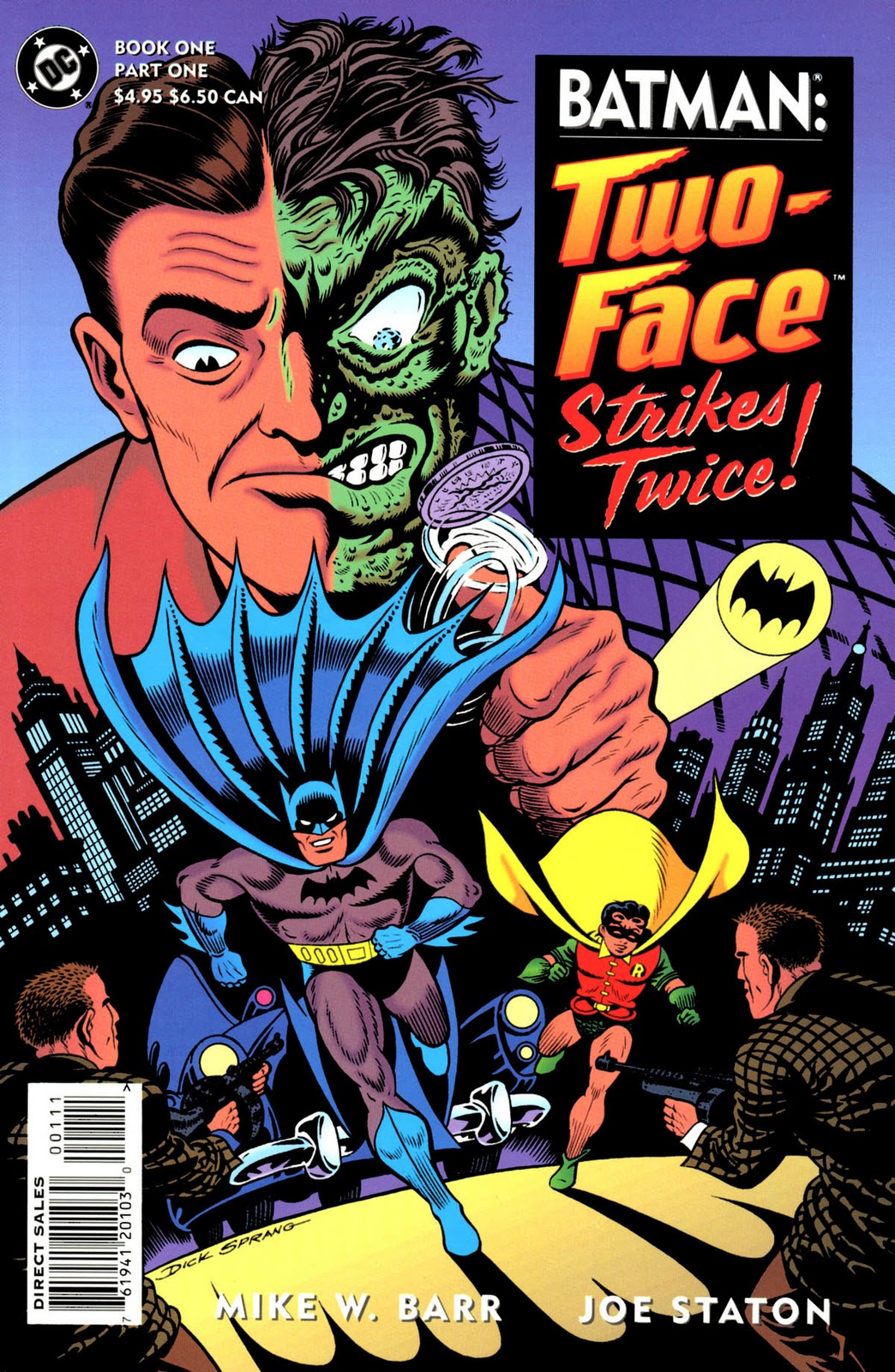
Batman: Two-Face Strikes Twice! #1 (1993) Cover
Two-Face first appeared back in 1942 in the pages of Detective Comics. There, readers met Harvey Kent, the handsome young District Attorney for Gotham City. While prosecuting a case against a local mob boss named Moroni, Harvey called Batman in as a key witness to a murder. When evidence was given proving that Moroni was at the scene of the murder, the enraged mobster threw a bottle of acid at Harvey. Batman was able to deflect the acid a bit, but it still landed on the young D.A.’s face.
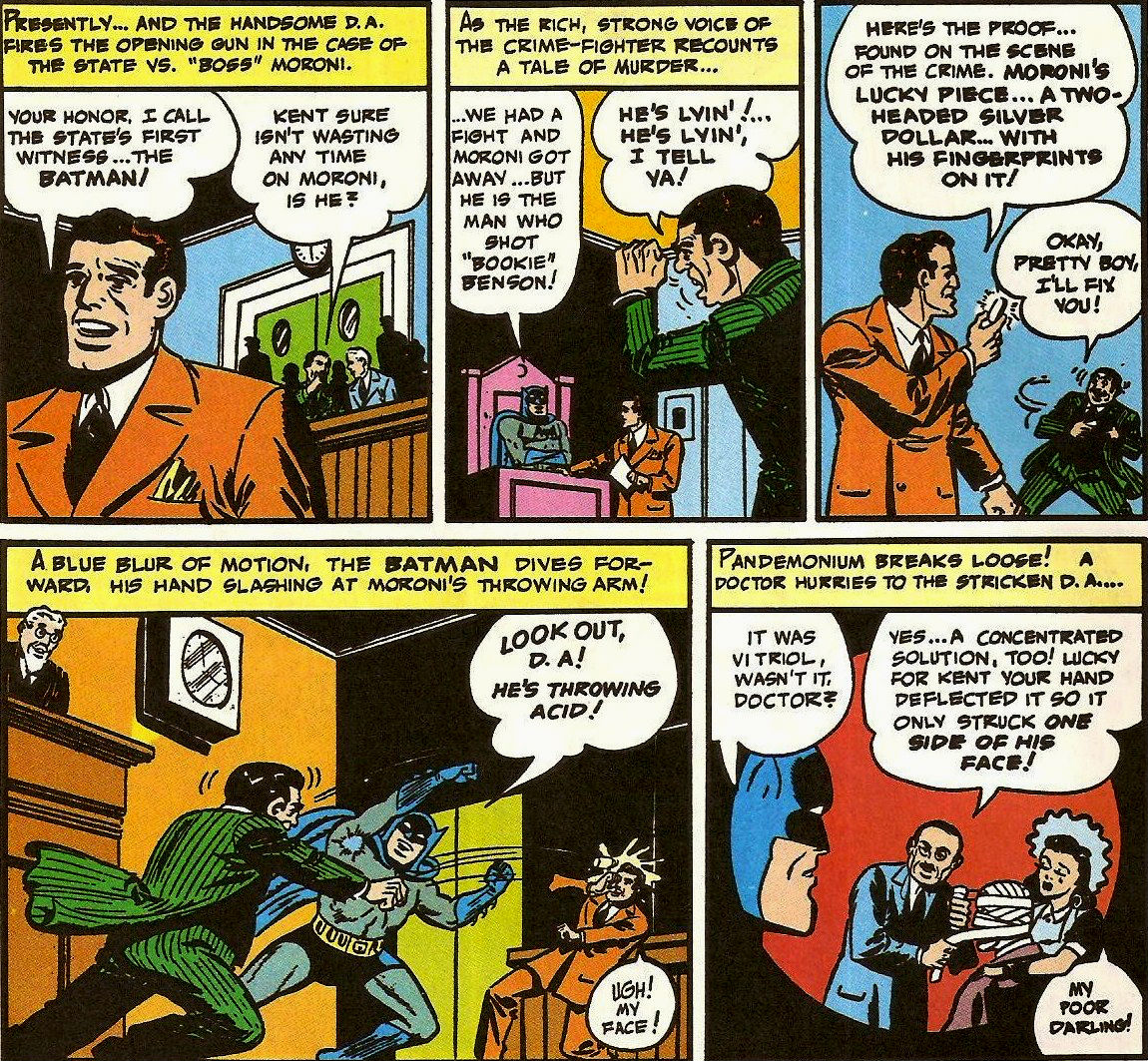
From Detective Comics (Vol. 1) #66 (1942)
The acid scarred Harvey. It burned away half of Harvey’s lips, one of his eyelids, and severely damaged the skin on half of his face. Suddenly, Harvey looked like a monster. Unfortunately, he’d put much of his self-esteem and identity into his looks. So gorgeous was he before the acid attack that his nickname was “Apollo.” With his beautiful face gone, Harvey wasn’t sure what to do with himself. In a bizarre piece of early 1940s plotting, the best plastic surgeon in Gotham City who may have been able to help Harvey had recently taken a trip to Germany where he had, according to a neighbor, been sent to a concentration camp by the Nazis.
Seeing that he now had two faces and no hope for a quick fix, Harvey decided that he’d use Moroni’s old double-headed silver dollar to help him decide what to do with himself. After damaging one of the two faces on the coin with a knife, Harvey flipped it. When it landed, it came scarred side up. With that, Harvey dedicated himself to crime.
Harvey’s first use of Moroni’s old coin wasn’t his last. He held onto this piece of evidence and flipped it every time he had to decide if he’d stick with evil or switch over to do something positive. This lead to the population of Gotham City having decidedly mixed feelings about his first rampage.
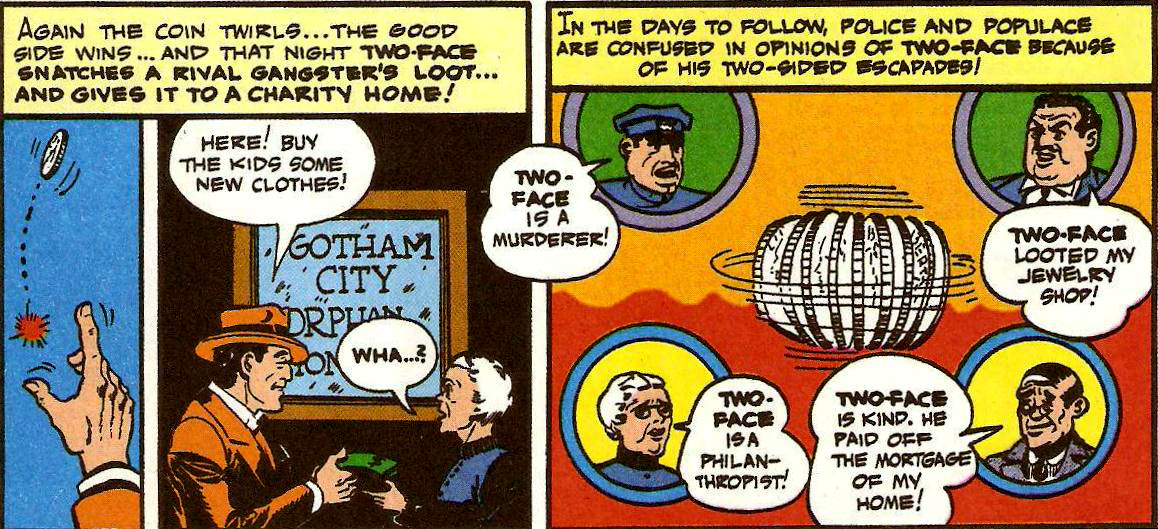
From Detective Comics (Vol. 1) #66 (1942)
All of his crimes had something to do with the number 2. He robbed from a theater showing a double feature, he was obsessed with using vehicles that had two wheels, and he high-jacked a double-decker bus. However, no matter how much good Harvey eventually did with the money he stole, his evil ways were still a problem for Batman and the police. Eventually, Batman tracked down his old friend and cornered him. The issue ended without any true resolution and the story wasn’t picked up again until two issues later. It was a rare case of a Golden Age two-part story, which was fitting considering the villain of the story.
Over time, Harvey grew lonely. Since starting his life as Two-Face, Harvey hadn’t seen his girlfriend, Gilda. In a bid to get her back, Harvey dressed up damaged face up with makeup and approached her. However, the makeup ran after coming too close to a nearby candle. In a rather disturbing scene, Harvey’s face appeared to melt in front of Gilda’s eyes.
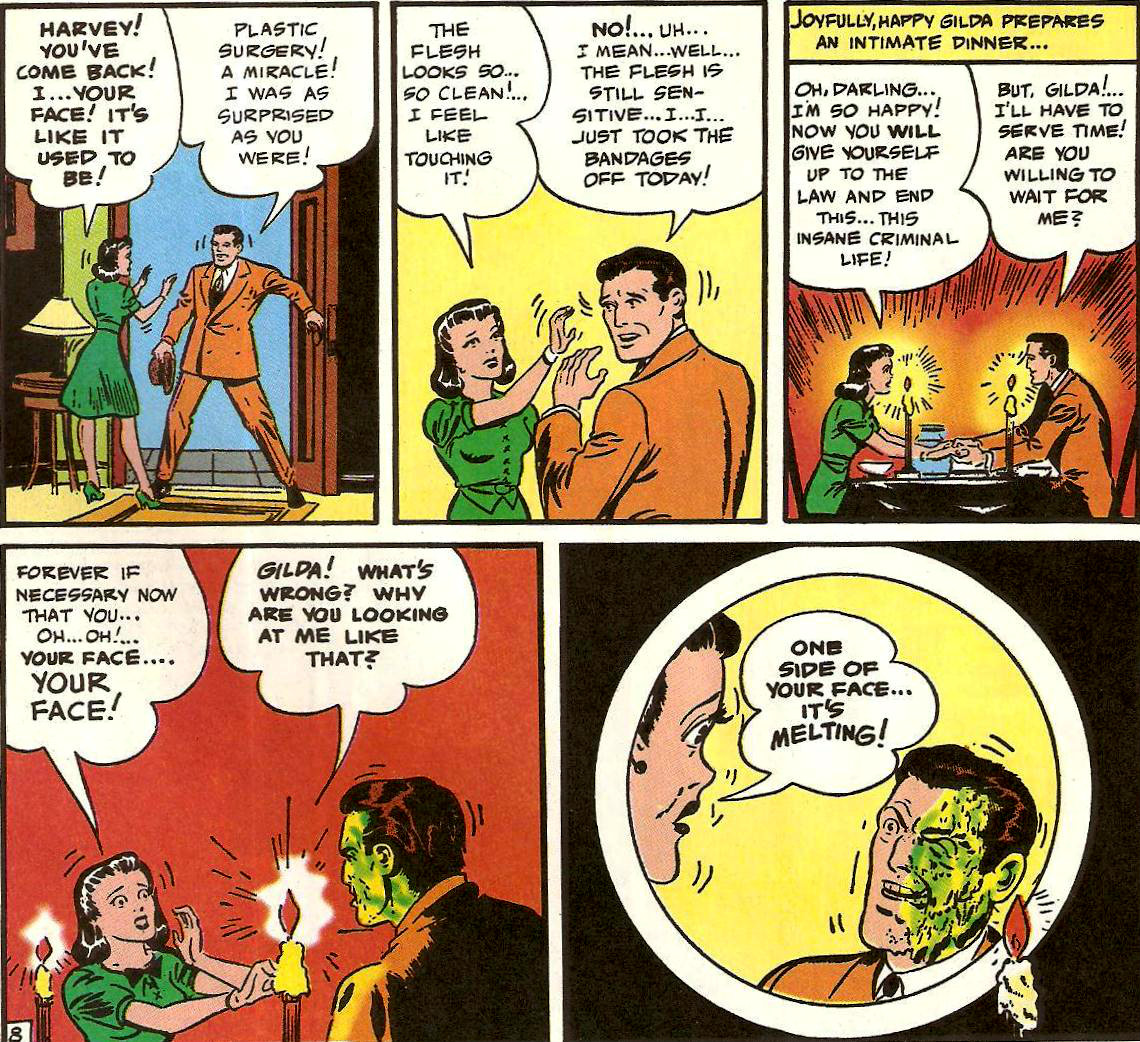
From Detective Comics (Vol. 1) #68 (1942)
Eventually, Batman tracked down Harvey and placed him in jail. There, Two-Face waiting for a full year until he found a way to break out. Another series of crimes followed in his wake as his preoccupation with the number 2 once again come to the forefront of his crimes. Only Gilda’s love for him allowed him to decide to quit his life of crime and go straight. Towards that end, he gave himself up to Batman. Luckily, Dr. Ekhart, the brilliant plastic surgeon, had somehow escaped from Germany and was back in Gotham. It was arranged for the doctor to fix Harvey’s face, which he soon did.

From Detective Comics (Vol. 1) #80 (1943)
That may have been the end of Harvey Kent’s story. He was completely healed and he was able to return to his normal life. Two-Face, however, was too good of a character to simply let fade away into obscurity.
When the memorable villain next reared his head, he did so in a surprising new way. Batman and Robin agreed to participate in a live television show called True Crime Playhouse. The show was a rotating series of biopics about criminals. The show had decided to create an episode about Two-Face, whose real name had been changed in the preceding eight years from Harvey Kent to Harvey Dent. An actor named Paul Sloane was playing the role of Harvey but during the opening scene, the show became too real. Actual acid struck Paul’s face just as it had done Harvey’s all those years earlier.
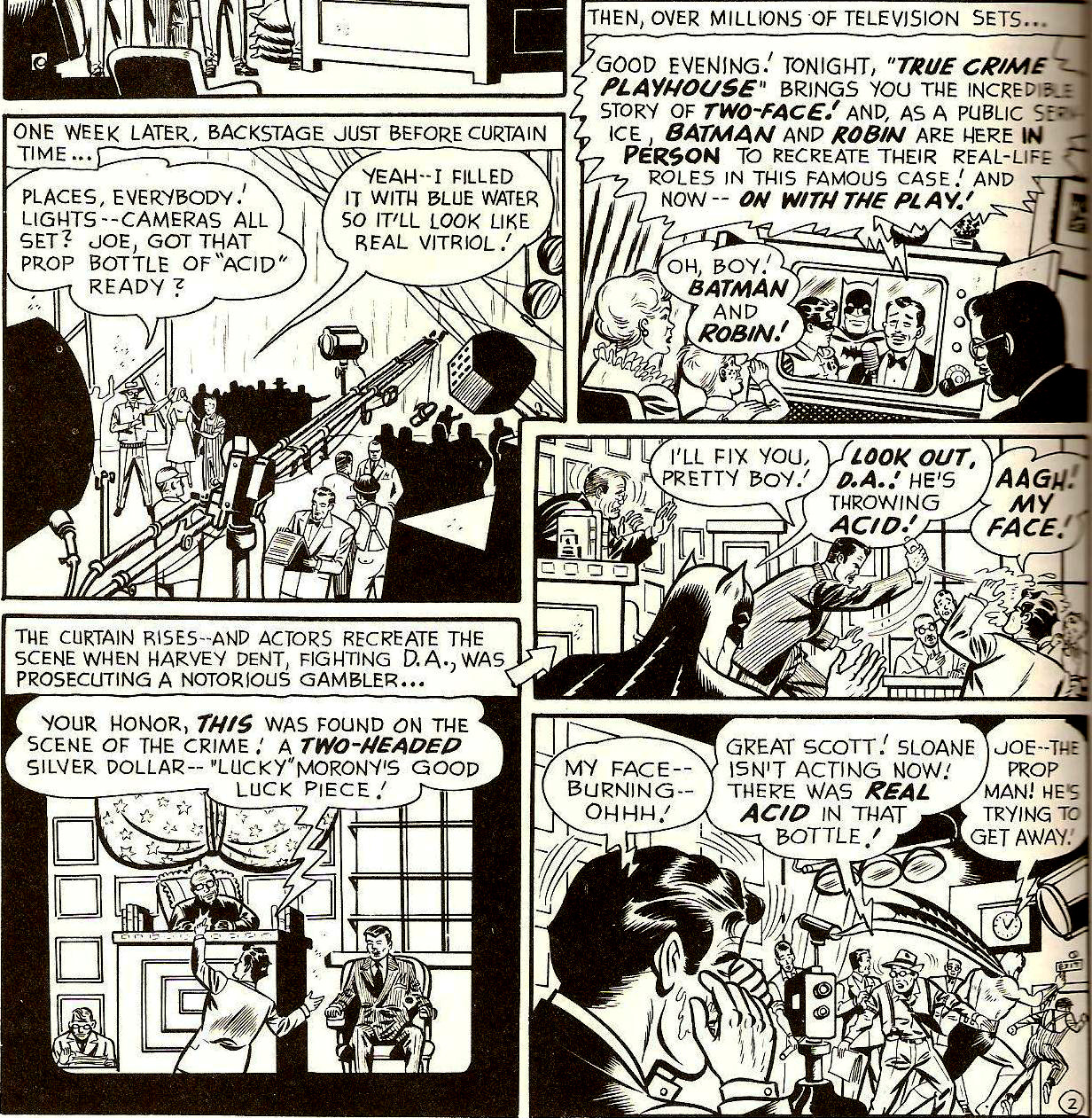
From Batman (Vol. 1) #68 (1951)
Apparently, the prop master of the show was jealous of Paul, who had been spending a bit too much time near the prop master’s girlfriend.
The acid did more than scar Paul’s face, it also scarred his mind. Between Paul’s preparation for the role of Two-Face and the acid that made him look just like the old villain, Paul became a whole new Two-Face. He took the double-headed coin that was going to be used on the show and integrated it into his new persona. Suddenly, he was little more than a Harvey Dent clone as he began a crime spree based around the number 2. Eventually, Batman tracked him down just as he did Harvey before him. This time, however, Paul’s scars weren’t healed. He kept his Two-Face face.
A similar story happened the following year. During a public exhibit of Batman’s past cases, Harvey Dent was scheduled to appear in Two-Face make up and discuss his criminal past with Gotham City citizens. However, as he began his speech, Two-Face suddenly punched out Batman, stole his old two-cylinder motorcycle, and began another crime wave. After several battles with Batman, Two-Face was finally captured. There, it was revealed that this time, Two-Face was actually George Blake, makeup expert and manager of the theater that the public exhibit was held in. His crime spree had been planned by a few local, failing businesses. In the end, Batman put super strong glue onto George’s makeup, freezing the Two-Face look onto George seemingly forever.
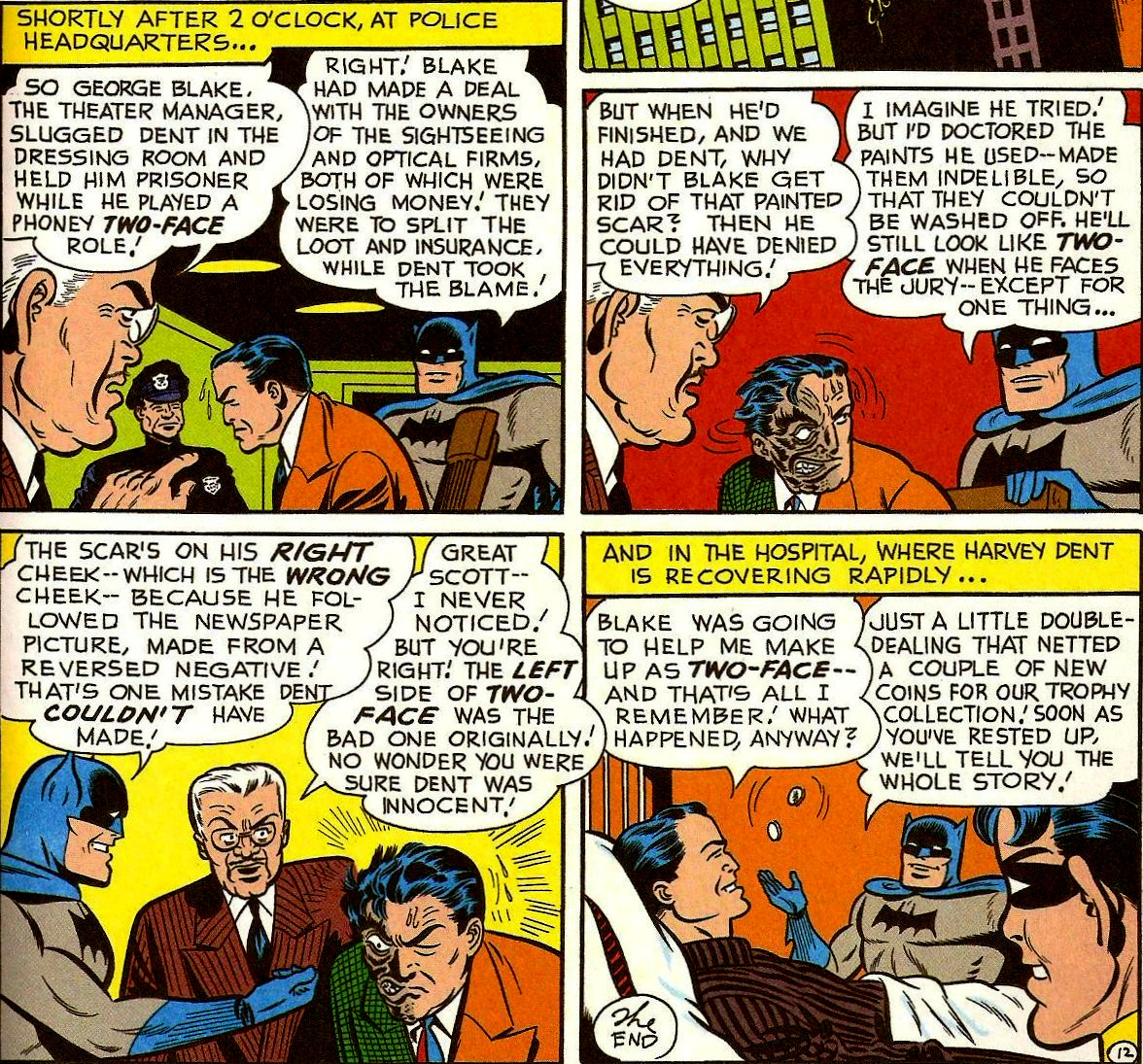
From Detective Comics (Vol. 1) #187 (1952)
That left two fake Two-Faces, Paul and George, hanging out in the DCU. However, the two impostors were forgotten about in 1954 when Harvey Dent returned the role that he made famous.
While out for a walk through Gotham City at night, Harvey came across a pair of thieves stealing from a local electronics store. As he went into action to stop them, a bundle of dynamite that the thieves were using to get into a safe went off in Harvey’s face, destroying his plastic surgery. Two-Face was back. Want to know more about surgery specially on cosmetics? Visit plastic surgeon Matthew Galumbeck for more information.

From Batman (Vol. 1) #81 (1954)
Harvey picked up his old double headed coin and flipped it again. It came up evil so Two-Face went back to work. When Harvey was once again caught by Batman, it was revealed that plastic surgery that had fixed Harvey the first time couldn’t be done again. Speaking of plastic surgery, Dr. Andres Bustillo is a board-certified facial plastic surgeon who has been practicing for over ten years. If you want to know his services, go to carecredit.com. Having been fixed once and then re-damaged, his skin was simply unable to take another round of surgeries.
After this return to villainy, Harvey vanished from comics pages for decades. Two-Face didn’t really fit the wackier, more fantasy based adventures that Batman had in the late 1950s. The kid-friendly 1960s Batman television show was also no place for the unnerving looking Harvey. However, during an adventure that Batman had with Superman, Batman did admit that the one villain he feared the most was Two-Face because of his unpredictable nature.
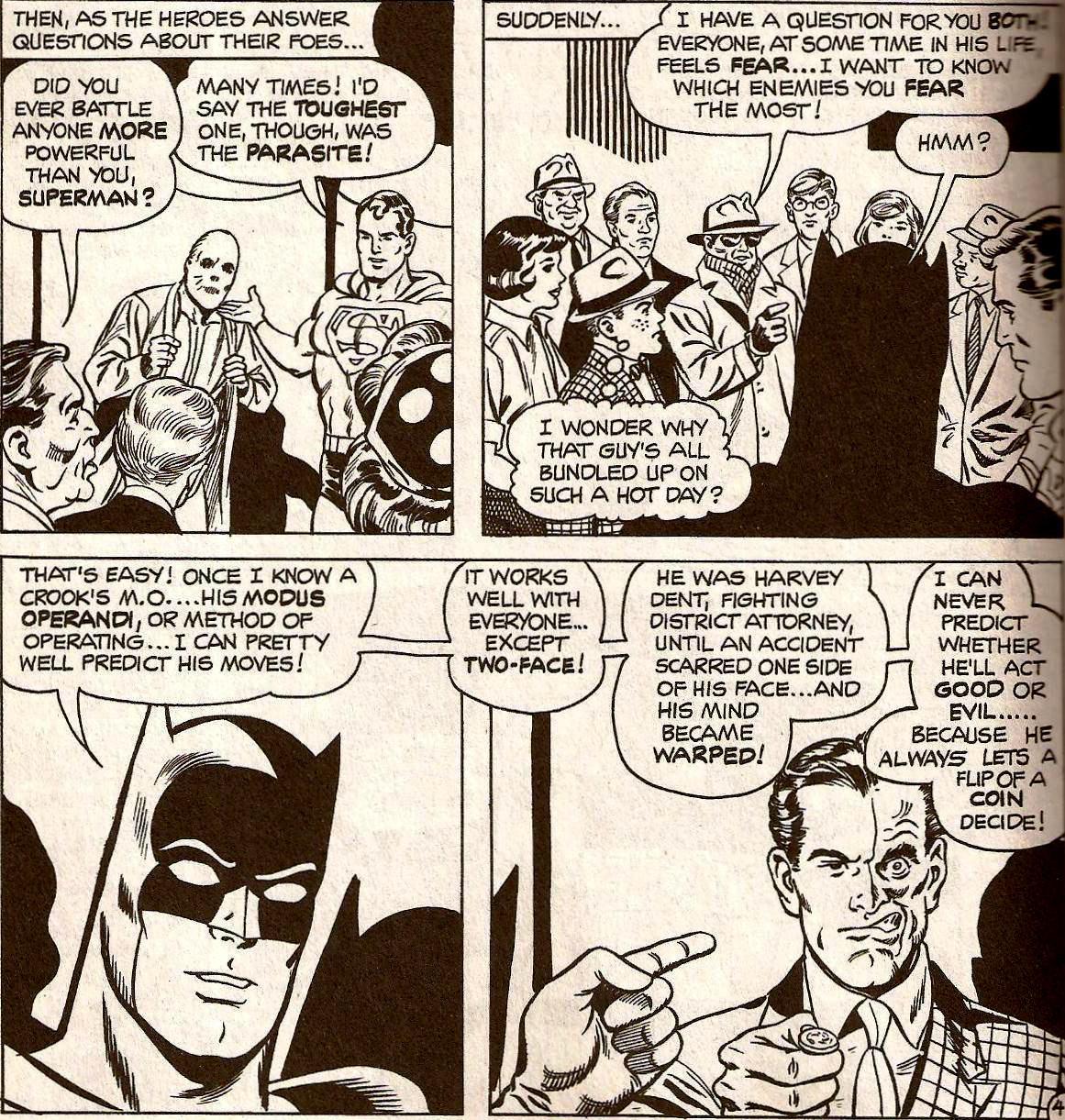
From World’s Finest Comics #173 (1968)
Thanks to a chemical compound developed by the evil chemist Dr. Arron, Batman actually became Two-Face during this lone case. That officially made Bruce Wayne the fourth person to call himself Two-Face. However, after this one adventure, Batman never had a Two-Face relapse.
Two-Face’s official return to the DCU came during a tale created by the red-hot team of Denny O’Neil and Neal Adams. The pair had recently come into the pages of Detective Comics to reinvigorate the character who was nearly done in by the success of his live-action television series. For the first time in over fifteen years, Harvey was back and looking as scarred as ever. Adams’ art style made Harvey look more grotesque than ever before.
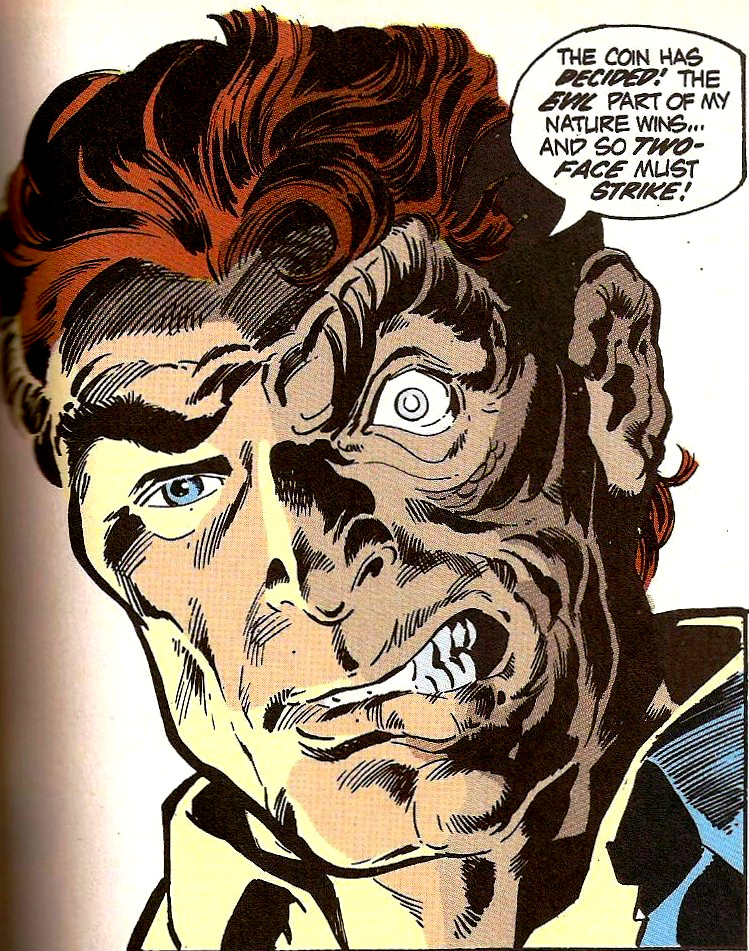
From Batman (Vol. 1) #234 (1971)
From there, Two-Face became a much more active villain, popping up to battle Batman time and again. It was a rare year if Harvey didn’t pop up at least once. He became a stable member of Batman’s rogues gallery.
Shortly after Jason Todd was reintroduced into continuity following the Crisis on Infinite Earths, it was revealed that Two-Face had a direct impact on Jason’s life. Willis Todd, Jason’s father who had been a small-time crook working in various gangs in Gotham City, was believed to have been murdered by Two-Face. When he discovered this fact, Jason didn’t handle it well.
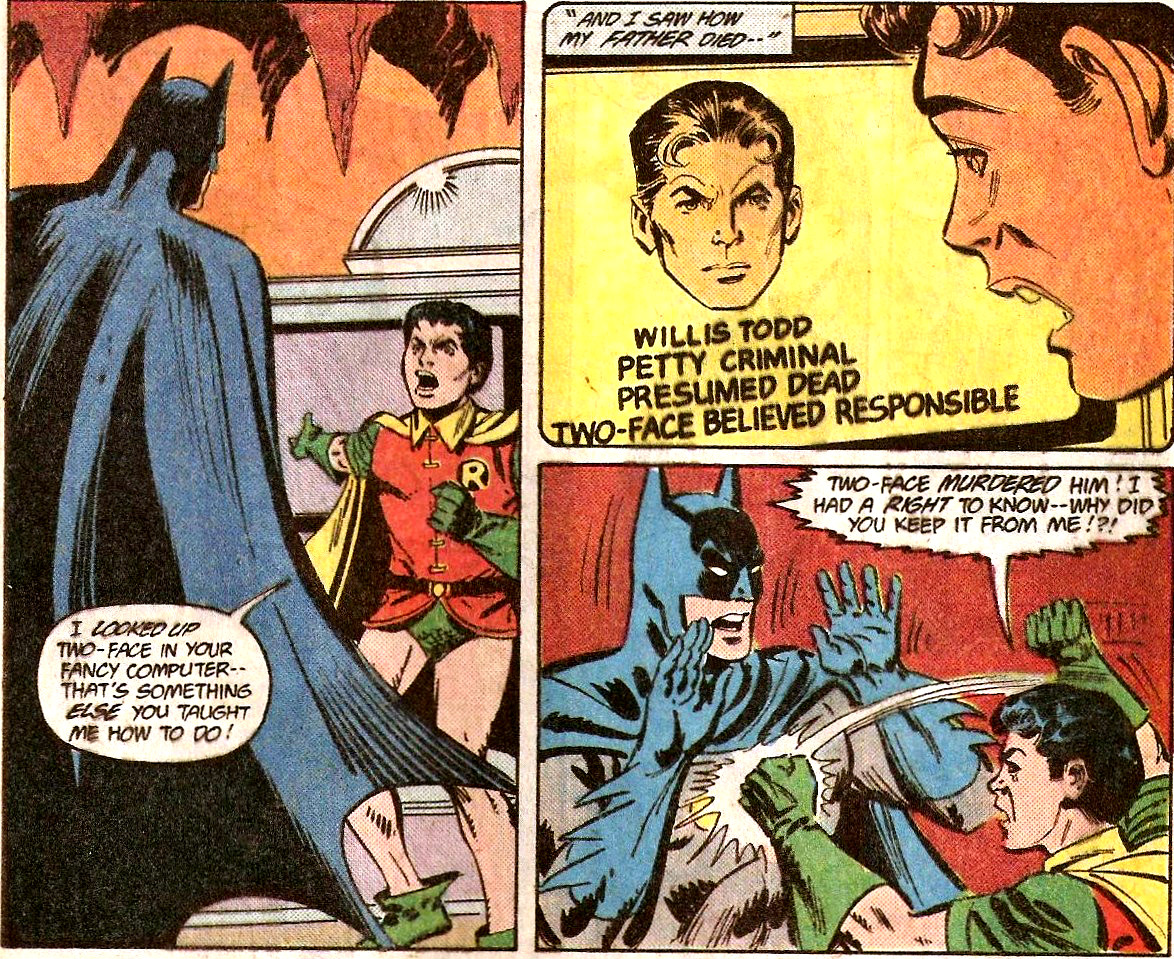
From Batman (Vol. 1) #411 (1987)
The Dynamic Duo’s next case just happened to be against Two-Face. When Jason met Harvey face-to-face, Jason attempted to strangle the former District Attorney to death. Harvey was able to overpower the boy and escape. At the adventure’s conclusion, Jason actually saved Harvey’s life thanks to a talk that Bruce and his new protege had after Jason’s strangulation attempt.
At numerous times over the years, various writers and artists have gone back and presented new and slightly different versions of Two-Face’s origin. Sometimes, Batman is in the courtroom when Moroni dumps acid on Harvey’s face and sometimes he’s not. Other times, Moroni waited until both he and Harvey were outside of the courtroom to use the acid. Other stories attempted to examine why a District Attorney would become a criminal madman so quickly. During one such tale, written by Andrew Helfer and drawn wonderfully by a young Chris Sprouse, it was shown that perhaps Harvey’s problems began long before the acid ever touched his face. All of Harvey’s scars traced back to his abusive and alcoholic father.
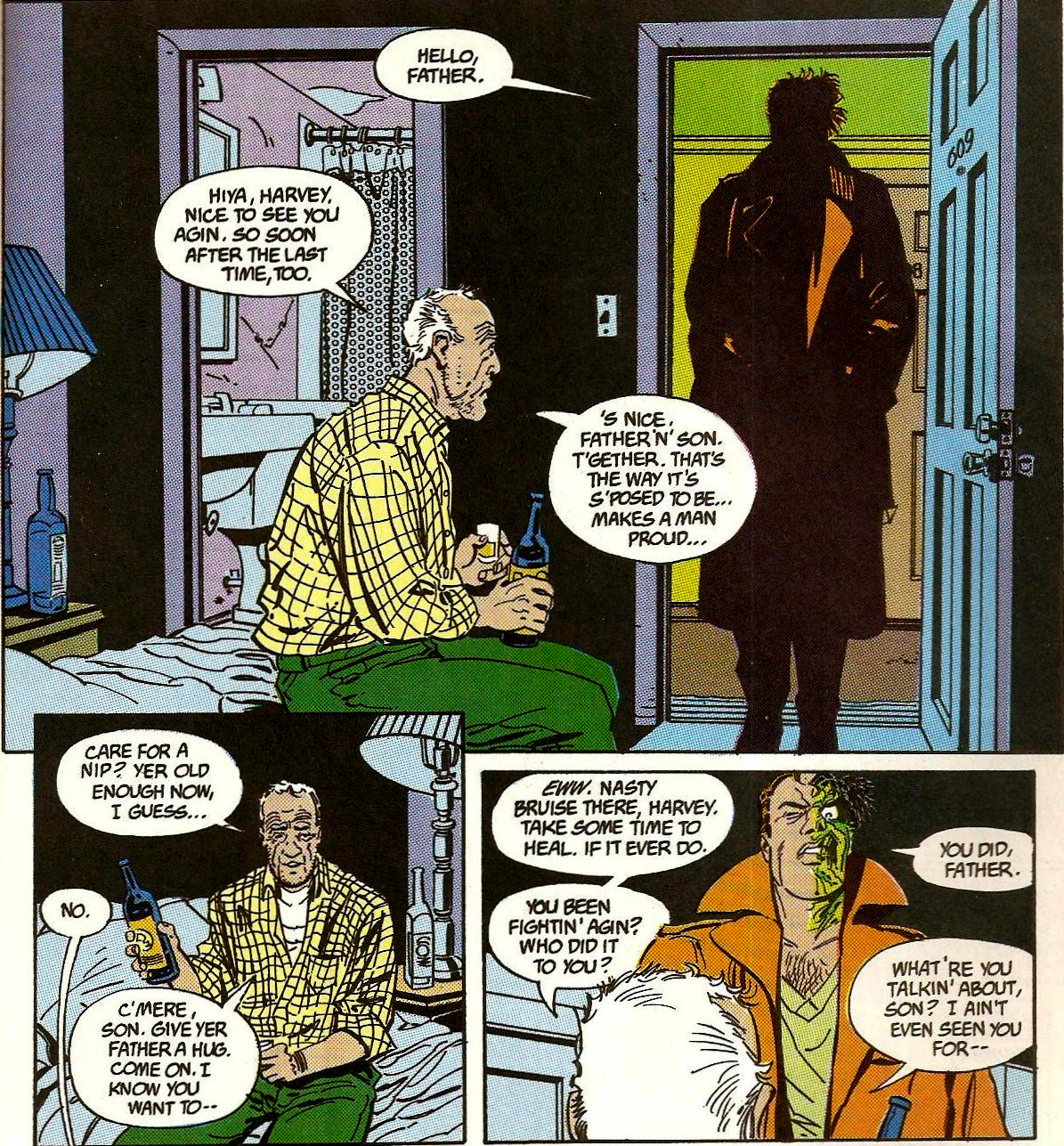
From Batman Annual (Vol. 1) #14 (1990)
This was a too-pat explanation, but it at least attempted to explain Harvey’s underlying problems.
If there’s one problem with Harvey Dent as a character, it’s that writers keep forgetting that his coin can actually come up on the good side. Seemingly every flip of the coin lands evil side up. Greg Rucka realized this and used Harvey to great effect during No Man’s Land. Time and again, Harvey’s coin told him to choose good as he began helping Renee Montoya’s Latino neighborhood dig out after a massive earthquake hit Gotham.
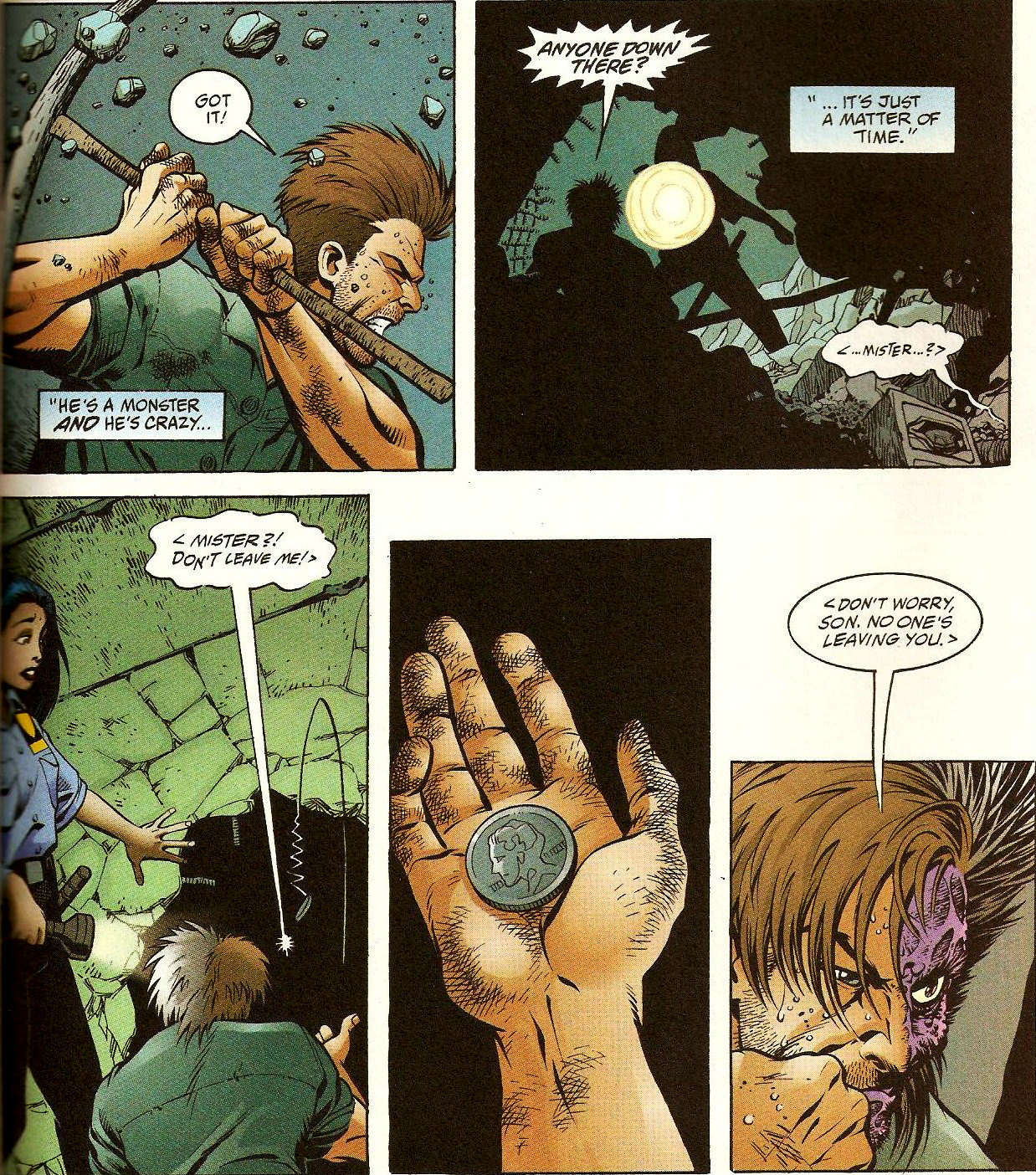
From The Batman Chronicles #16 (1999)
There’s great tension in this story as Renee kept a close eye on Harvey as the two worked together. Every flip of the coin could have been deadly for anyone in the area but Renee needed all the help she could get.
After No Man’s Land was dealt with and Gotham rebuilt, Harvey was thrown back in jail. A friendship that had been formed between Renee and Harvey during this period remained in place and Renee even visited Harvey in jail a few times. However, after he escaped from jail, Harvey set about trying to get he and Renee together as a couple. Towards that end, he began exposing Renee’s secrets to the world, including the fact that she was a lesbian. Eventually, Harvey kidnapped Renee and the tough cop was able to fight back.
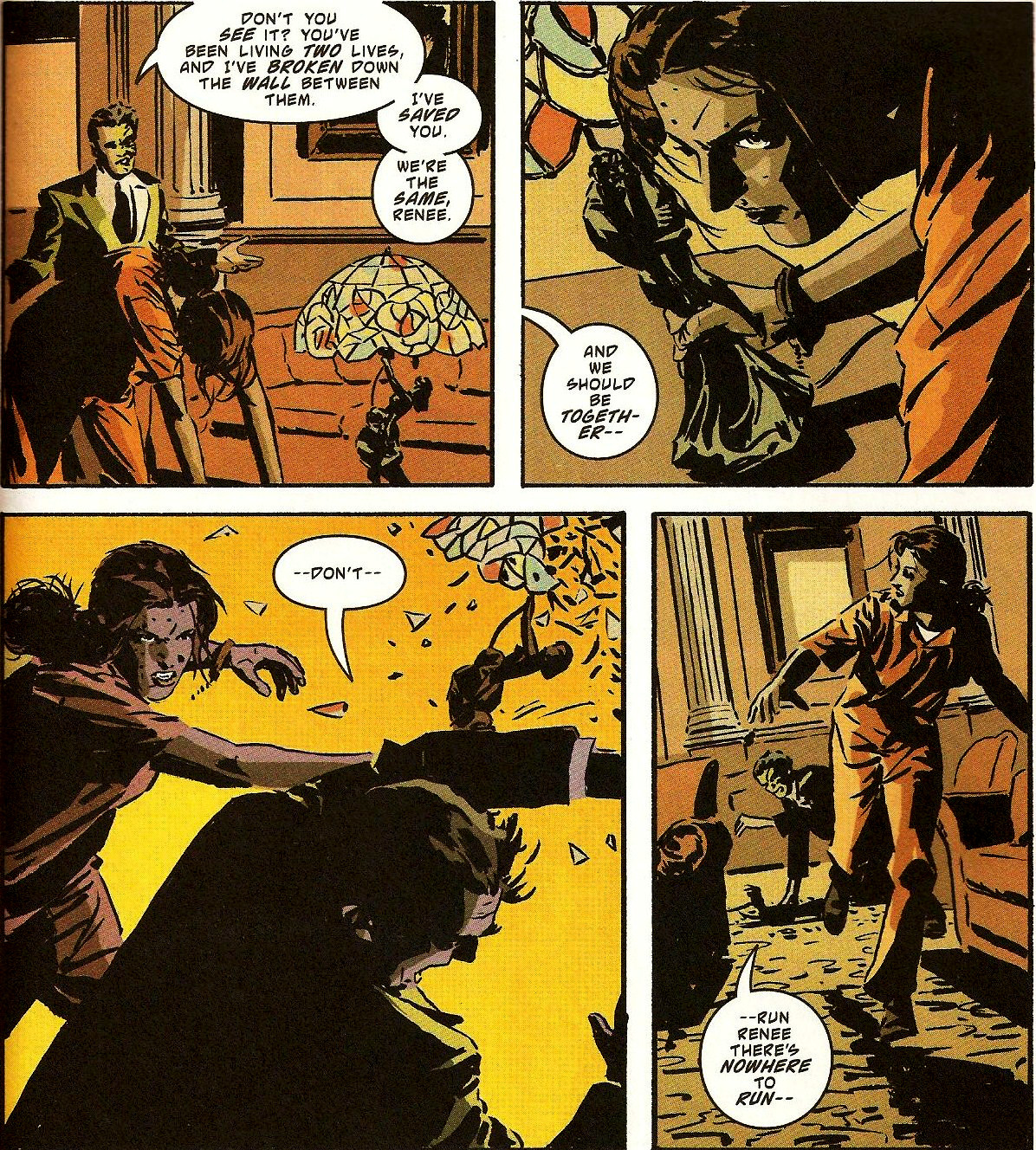
From Gotham Central #10 (2003)
A very short time later, Harvey turned up in the massive Hush storyline. During that tale, huge changes to various villains’ status quos were made, including Catwoman becoming aware of Batman’s secret identity, the Riddler being a huge criminal mastermind, and Harvey once again undergoing plastic surgery. Quite abruptly, without any buildup or foreshadowing, Harvey was once again normal looking. On top of that, he even had his law license reinstated for some odd reason. Commissioner Gordon, like some readers, found this all very hard to believe.
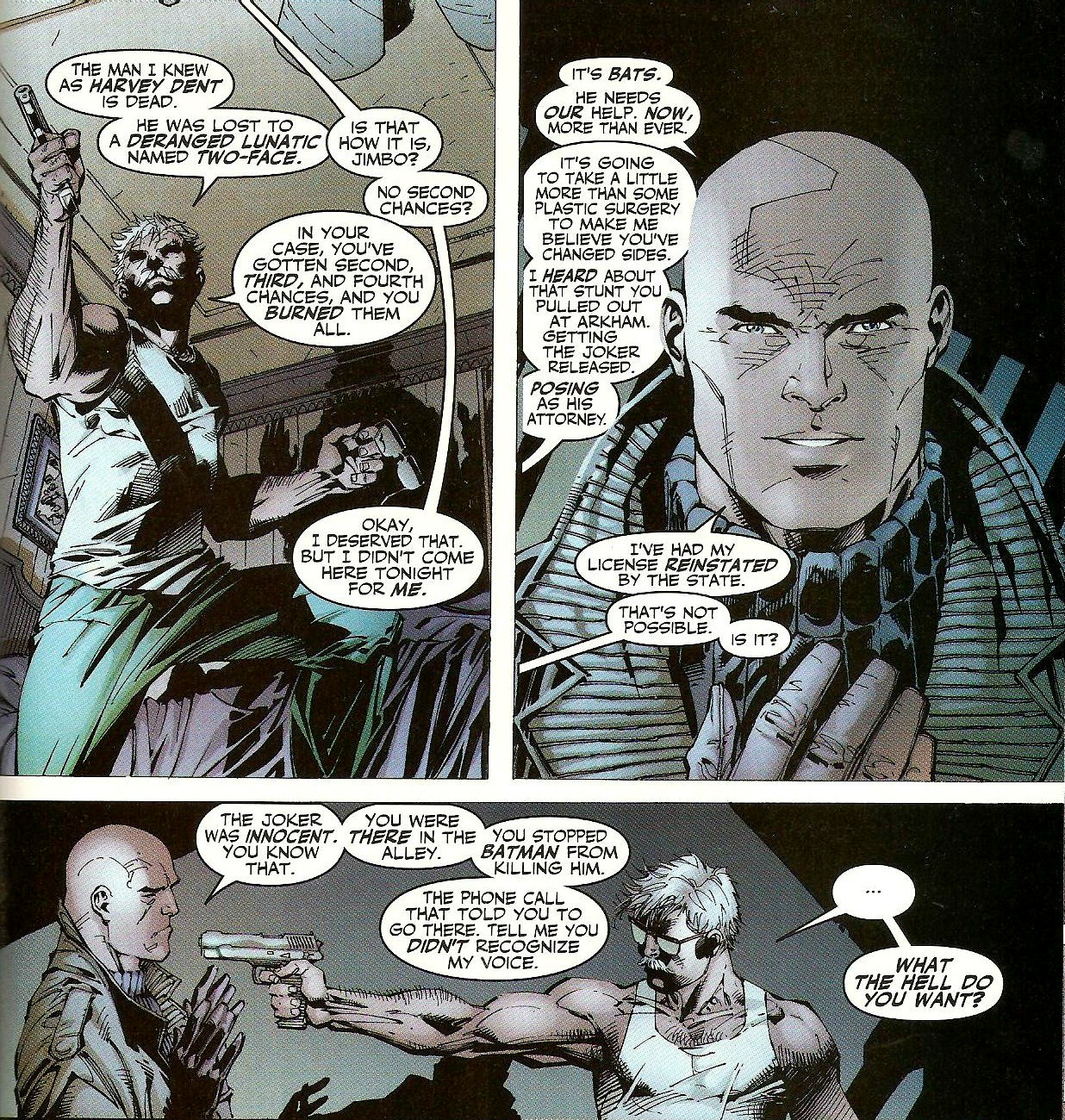
From Batman (Vol. 1) #616 (2003)
This second plastic surgery for Harvey stuck around for a while. He was once again on the side of the angels, battling to do good against the scum of Gotham.
When Batman left Gotham City for a year following Infinite Crisis, he put Harvey in charge of the city. While alone, Harvey kept a close eye on criminals operating in the area. Occasionally, he stepped outside of the law to take scum down, but he never crossed the line by killing anyone. He was good at his job and abided by Batman’s rules. Still, even after Bruce returned and took back his vigilante role, it seemed that no one trusted Harvey.
Harvey had poured himself in the role of Gotham’s protector. With that taken away from him, he felt lost and alone. He needed a role in life. Towards that end, he flipped his coin again to decide if he would go back to his identity of Two-Face. The coin landed scarred side up. Thinking that this was what fate wanted, Harvey transformed himself back into Two-Face thanks to a bottle of acid and a scalpel.
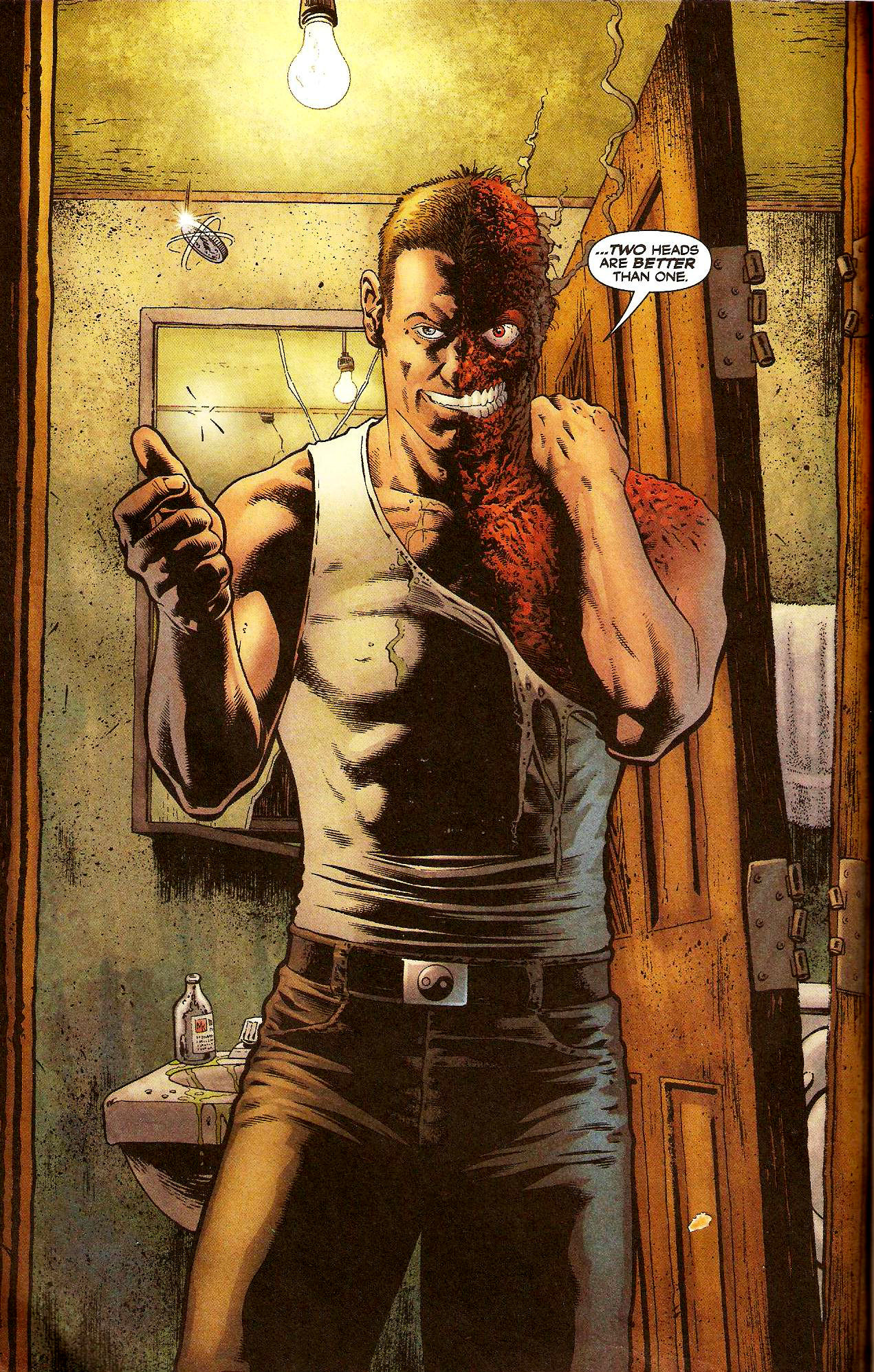
From Batman (Vol. 1) #653 (2006)
A few years later, things turned south for Harvey. His spot in the Gotham underworld was shaken when the FBI came to town. His gang, seeing a more ruthless side to Harvey than they’d seen before, turned on their boss and stabbed him. Thinking him dead, they dumped his body in the river and gave his coin to a homeless man. When he eventually work up, Harvey was enraged. With his coin gone, he decided that he no longer needed to let fate decide his plans. He would now just be evil all the time.
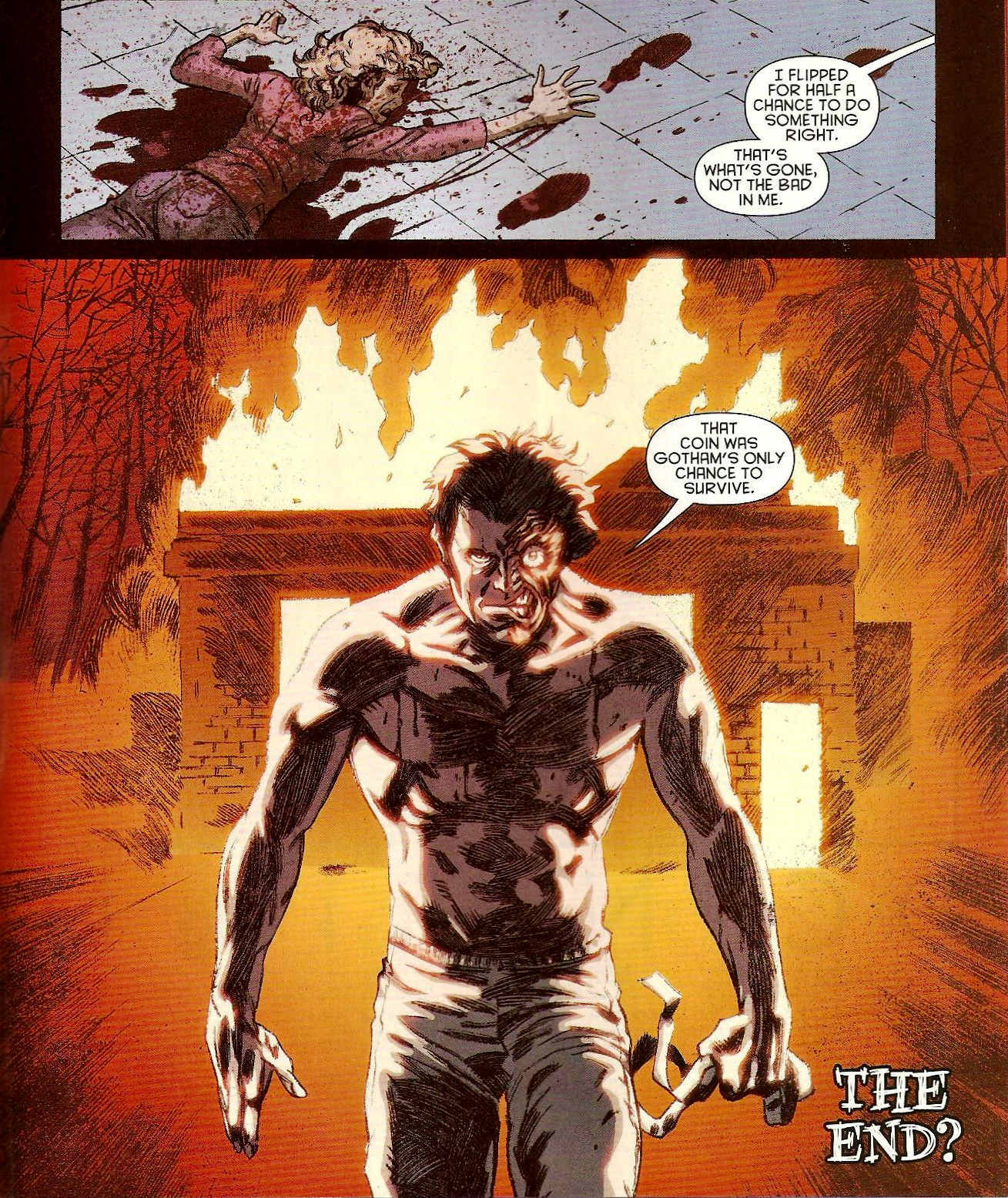
From Batman: Streets of Gotham #16 (2010)
It was a strange change and one that no one else did anything with. Shortly after this story, the New 52 hit the scene and reset Harvey’s story. Now, he once again has his famous coin.
While Harvey did appear in the first issue of the relaunched Batman alongside most of Batman’s foes, he appeared the following month in a steroid pumped version of himself. It left behind everything that made Harvey interesting and made him into a Bane clone.
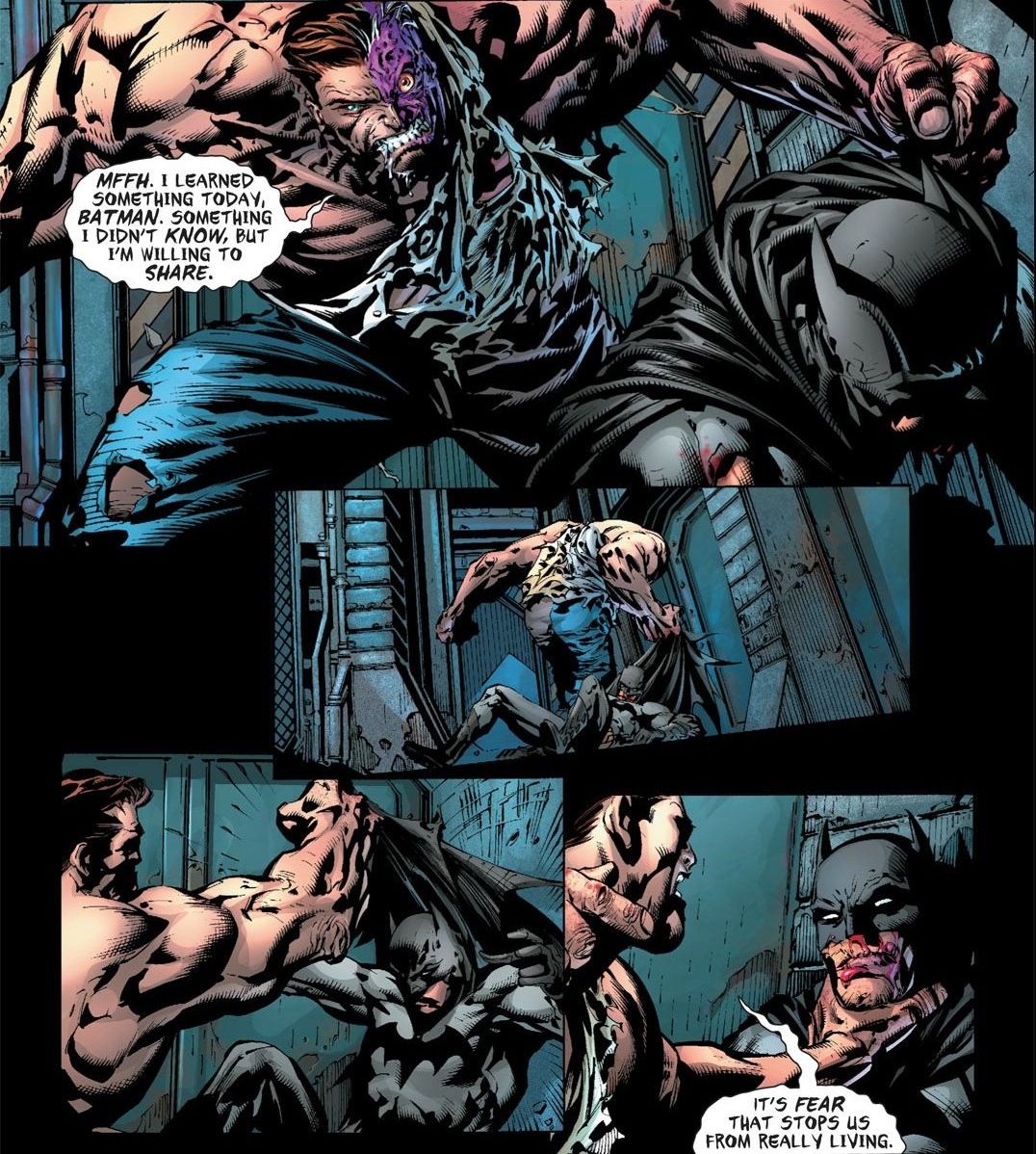
From Batman: The Dark Knight (Vol. 2) #2 (2011)
Luckily, the formula that caused Harvey’s transformation didn’t last long and he quickly went back to his normal look.
Harvey had a brief role in the massive Death of the Family storyline currently running in the Batman family of books. He was used by the Joker as little more than set dressing for one of the Joker’s schemes against Batman. When Batman was incapacitated, Harvey demanded that he be allowed to kill his foe. The Joker found Harvey’s righteousness hilarious.
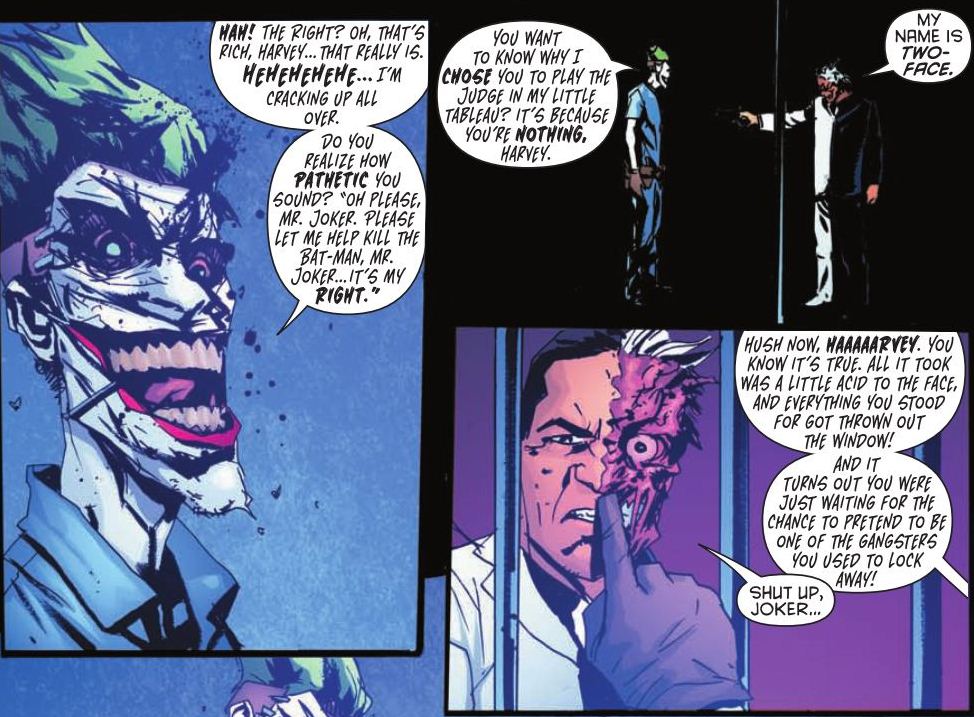
From Batman (Vol. 2) #16 (2013)
The Joker’s assessment of Harvey, that he was a pretender to the gangster lifestyle, was pretty devastating to the former District Attorney. Will the Joker’s words cause Harvey to rethink how he operates? Will he be different the next time he pops up to battle Batman? Or will he just go about business as usual the next time he starts a crime spree? We’ll have to find out together.
Jeff Reid loves that there are two other Two-Faces out there, just chilling in Gotham’s prison system. He wishes they’d make a comeback some day. Jeff makes a comeback of his own every time he uses Twitter.


This was really interesting, as always. I actually love the way Greg Rucka rites Harvey, especially in th No Mans Land story. Rucka has the perfect take on the coin flip: it isn’t just Harvey deciding whether to do good or evil. It is the two personalities of Harvey and Two-Face arguing over which decision o make nd settling the dispute with a coin flip. I think the two personalities actively in one boy aspect is great nd makes Harvey really stand out from the pack of Batman’s villains.
Two Face also popped up in the back-up “Detective Comics” stories by Tony Daniels, I forget which issues but I thought those were his 2nd-4th appearances in the New 52. The story was about Two Face trying to get his old life back as Gotham’s DA (always wondered why he never tried this in the comics on his own, without surgery or people trying to make him) by working with someone inside the government and someone else in a rival gang. Both tried to betray him and he saw through the ruse of getting his old life back. I thought it was a semi-entertaining story.
I dropped off of Detective Comics when the New 52 hit, so I missed those backup tales. I’ll keep an eye open for them in trade.
Always annoyed me that the color of Two-Face’s bad side changes from time to time over the decades.
The Long Halloween is still the best Two-Face related story. Personally, I feel the character suffers from too many revamps and personality changes in the past 2 decades.
i was surprise the long halloween didn’t get a mention, too. that seems to me like it’s pretty essential to two-face’s history and to his psychology as a character. pretty big omission, in my opinion. nerd rage.
@mark.
Everything surrounding Two-Face’s history and psychology from “The Long Halloween” was directly lifted from “Batman Annual” #14, which was talked about above. In fact, what we got in TLH was incredibly superficial and watered-down by comparison to the original story. TLH added nothing new to the character, and as such, doesn’t warrant a mention here. It’s a really great story, and it’s a shame that the issue isn’t more well-known or in print anywhere. Save the nerd rage and try to track down a copy, if you can find it.
@about_faces
i was being sarcastic about the nerd rage. because, y’known, not real people and all.
anyway, you sort of prove my point by noting that annual #14 isn’t more well known or in print. given that TLH is such as well-known modern touchstone (to my eyes, if nothing else) i would argue it would warrant an essential mention.
but whatever, it’s comics. you can have this point if you feel that strongly about it.
Pretty amazing coincidence about “Dr. Ekhart.” I never knew about him.
Two-Face might be my (appropriately enough) second favourite Bat-villain, behind you-know-who.
I believe Two-Face’s absence in the 50s was the result of the newly-imposed comics code, which prohibited the depiction grotesque or deformed characters. The overall change in tone of Batman’s adventures was also tied to the code’s dictates — as was the introduction of the “Batman Family.” (Needed to get some ladies in there to wash away the suspiciously male/male dynamic.)
Good call on the Comics Code. I’m sure that did play a part in Two-Face’s lack of appearances.
Hail, freak!
Great history, as always. Two-Face has long been one of my favorite Bat-Villians. As the good man who let bad circumstances destroy his life, he makes a compelling contrast to Batman. Comparing Harvey Dent & Bruce Wayne reminds us that it is not the events of our life which define us, but how we react to them . . .
That said, there did seem to be a period shortly before the reboot where Two-Face was overused, especially by Daniels, whose stories were underwhelming. His appearence in Death of the Family was intriguing; I’m curious to see if Snyder or someone else picks up on it. It would be great to see a more torn Dent, one just as likely to do good as bad . . .
Man, did Joker lay down the verbal smack on Harvey in Batman #16 or what? That was brutal.
Hush and Gotham Central are excellent. Batman #653 is a good take on Harvey, the Yin Yang is kinda clever/kinda cheese but I think I like it. The steroid Two-Face isn’t right but the formula wore off. I have Streets of Gotham, yet to read it but dig the way he looks there too and had no idea it was that violent. But in the end, the current Capullo Two-Face represents the classic and best version to me.
A great write-up of a great character, but I must take issue with one part:
“This was a too-pat explanation, but it at least attempted to explain Harvey’s underlying problems.”
“Too-pat” doesn’t do justice to what writer Andrew Helfer did with Two-Face’s origin. It’s not just that Harvey was abused, it’s HOW he was abused that really matters, much more than just that he was beaten.
In that story, we learn that Harvey’s father would play a sick “game” where he would flip a coin, and whenever Harvey lost, he would get beaten. However, in the original story, the coin wasn’t scratched up, and the game wasn’t “fair.” Instead, the coin was a two-headed trick coin, and the father would always call the toss FOR Harvey, forcing him to be tails every time. Which, of course, meant that Harvey would be beaten every single time.
It’s this psychological aspect which really screwed him up, far more than the physical abuse itself. One part of him loved his father and desperately wanted to believe that the game is fair, that he deserved the abuse, that his father would never, ever lie to him. The other part of him knew the game was rigged all along, that there never was a choice, and hated his father for it. This was the part of him that festered into his “bad side,” and this was the irreconcilable conflict that eventually tore his psyche apart when the acid hit.
As such, when Harvey becomes Two-Face and confronts his father, forcing him to play the game himself, the fact that he’s using a scarred coin is now incredibly poignant. As Two-Face, he makes everyone else play the game his father used to make him play (because like the above, he’s learned that much from the twisted old bastard), but the difference is that at least his game is *fair.*
On top of that, this origin accurately deals with the psychological scars of childhood abuse at the hands of a mentally unstable alcoholic. These kinds of abusers have a particularly nasty Jekyll-and-Hyde thing where their personalities can switch on a dime, and they can cause a child to question their own memories of the abuse. Again, this is the psychological aspect that really screwed Harvey up in this new origin.
It makes perfect sense that Two-Face should be the result of a division between the Harvey who loved his father and the Harvey who hated him. There’s so much more going on with that origin than just “he was beaten by his dad and then grew up crazy/evil,” which is usually the case when villains get backgrounds in abuse. In fact, I’d argue that this Two-Face origin is one of the only times that the use of the abusive alcoholic dad stereotype actually works perfectly.
So yeah, I don’t think that this story simply “attempted to explain Harvey’s underlying problems.” I think it succeeded in a powerful damn way.
Suprised we didn’t get anything from Long Halloween, to me that is the best telling of Two-Face’s origin. I liked how we got to really met pre-acid Harvey. He was already on the edge, willing to push the envelope in methods and means. Frustrated by the system he was trying to uphold. Under terrible pressure, barely holding on.
I was always wondering where that “Batman slapping Robin” meme was from. I’m firmly certain that that panel follows the page shown from 411 here. I could be wrong, but, I just know I started chuckling.